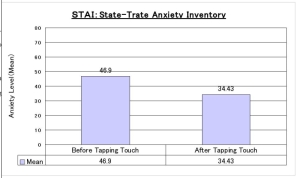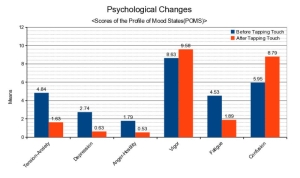Results of Scientific Research
1. Changes in Psychosomatic Senses
250 healthy adults, ages 18 to 75, were asked to fill out the Psychosomatic Sense Checklist (PSC). PSC is a pencil and paper questionnaire and includes 35 sense items such as feeling tired, stiff shoulders, neck tension, feeling sad, anxious, lonely, happy, relaxed, energetic, etc. Each item has a rating scale of 1 to 4, where 1 is the lowest and 4 is the highest.
The attendees rated their senses both before and after doing Tapping Touch. Their age range was between 19 and 73, and the average age was 41.
The data was then statistically analyzed and broken down into 3 different categories (indexes). These were: 1) Index related to stress, fatigue, tension, 2) Index related to positive emotions, and 3) Index related to negative emotions. In each item in all categories, statistically significant changes were seen. The results of these analyses are shown in the following graphs.
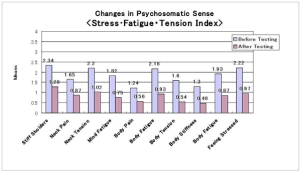
Statistical Significance:
Before-After Comparison of Stress/Fatigue/Tension :(t = 22.81, p < .001);
Each Sense Item :(p < .001)
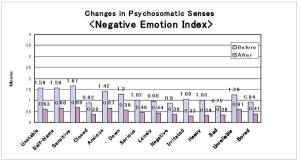
Statistical Significance:
Before-After Comparison of Negative Emotions :(t = 19.23, p < .001);
Each Sense Item :(p < .001)
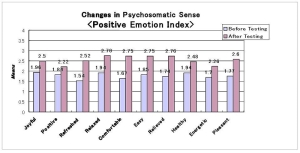
Statistical Significance:
Before-After Comparison of Positive Emotions :(t = 22.81, p < .001);
Each Sense Item :(p < .001)
62nd Annual Conference of the Japanese Society of Public Health, 2003.
- Top of this page
- 1.Changes in Psychosomatic Senses
- 2.Changes in Anxiety Level
- 3.Changes in Brain Waves and Autonomic-Nervous System
- Summary of Neuro-Physiological Changes
- 4.Changes in Serotonin and Psychological States
2. Changes in Anxiety Level
The State-Trait Anxiety Inventory (STAI) was used with 65 subjects, aged 20 to 70. The average age was 41. There are two subtests to the STAI test: State and Trait. In this study, only the State subtest was used in order to measure the subjects' level of anxiety immediately before and after giving and receiving Tapping Touch.
General research has established that a normal anxiety score level is 45 (Mean score). Subjects for Tapping Touch scored an average of 46.5 before Tapping Touch, which is about the same as the norm. After receiving and giving Tapping Touch, their score was reduced by about 10 points, which is statistically significant.
Presented at the 62nd Annual Conference of the Japanese Society of Public Health, 2003.
- Top of this page
- 1.Changes in Psychosomatic Senses
- 2.Changes in Anxiety Level
- 3.Changes in Brain Waves and Autonomic-Nervous System
- Summary of Neuro-Physiological Changes
- 4.Changes in Serotonin and Psychological States
3. Changes in Brain Waves and Autonomic-Nervous System
At the Neuro-physiology Laboratory in Kinan Hospital, Mie, Japan, a group of 10 subjects were tested for physiological changes using the following neuro-physiological equipment and questionnaires.
- Thermography : measuring the changes in skin surface temperature
- ECG : measuring the changes in the Heart Rate Interval Variability Coefficient (CVRR)
- EEG : measuring the changes in brain waves (alpha waves)
- The Psychosomatic Sense Checklist (PSC)
- The State-Trait Anxiety Inventory (STAI)
Of 10 subjects, 5 subjects fell asleep during the assessment later shown by the analysis of obtained brain-wave data. They seemingly became very relaxed and fell asleep during the measurement after Tapping Touch. Due to the sensitivity of measurement equipment used, their results were considered not compatible with those who were awake and thus invalid for the current study. The following summary includes only the 5 subjects who were awake during the measurement after receiving Tapping Touch.
| Age | Sex | Awake | Subjective Stress | Physical Stress | STAI (Anxiety) | CVRR | Thermography (Skin Temp.) | Brain Waves |
|---|---|---|---|---|---|---|---|---|
| 33 | M | Yes | High | -18 | -26 | +1.88 | +7.5 | +90.3 |
| 18 | M | Yes | Moderate | -9 | -12 | +1.08 | -1.1 | -82.6 |
| 18 | M | Yes | Low | -2 | -10 | -0.09 | +1.1 | +144.9 |
| 18 | M | Yes | Low | -2 | -2 | -0.42 | +1.1 | +49.5 |
| 44 | F | Yes | Low | 0 | -1 | +0.05 | +0.9 | +46.6 |
- Top of this page
- 1.Changes in Psychosomatic Senses
- 2.Changes in Anxiety Level
- 3.Changes in Brain Waves and Autonomic-Nervous System
- Summary of Neuro-Physiological Changes
- 4.Changes in Serotonin and Psychological States
Summary of Neuro-Physiological Changes
Overall results indicate that those subjects with higher levels of subjective stress tended to show greater increases in skin surface temperature and the heart rate variability coefficient, indicating greater activation of the parasympathetic nervous system.*
Tapping Touch also tended to increase alpha waves, suggesting that Tapping Touch encourages brain relaxation. Alpha waves are commonly found when the brain is highly relaxed, but not asleep.
Future research is needed: 1) with a larger number of subjects, including subjects under a high level of stress, 2) using A-B Research Design*, and 3) under research conditions that prevent subjects from falling asleep during assessment.
- * NOTE 1: Our normal heartbeat is irregular. It is known that healthy heartbeats have a certain irregularity, while a troubled heart has a regular rhythm. The ECG heart rate interval variability coefficient (CVRR) measures this irregularity. As this variable increases, it is thought that the heart becomes more rested, and relates to greater activation of the parasympathetic nervous system. What it indicates is that a person's body is resting, and in the process of repairing itself.
- * NOTE 2: AB Research Design is a simple way to measure before and after. It is simple and easy to measure. The drawback is that as time goes on changes will occur that may affect the results. The ABC Research Design can be more accurate because another activity or stimuli is added so that effects changed by time are prevented.
Results were presented at the 62nd Convention of the Japan Society of Public Health (2003).
- Top of this page
- 1.Changes in Psychosomatic Senses
- 2.Changes in Anxiety Level
- 3.Changes in Brain Waves and Autonomic-Nervous System
- Summary of Neuro-Physiological Changes
- 4.Changes in Serotonin and Psychological States
4. Changes in Serotonin and Psychological States
Serotonergic (5-HT) neurons are known to play a role in the suppression of anxiety, tension, pain and depressive symptoms among humans. Also, previous scientific studies have established that 5-HT neural activity is enhanced by rhythmic behaviors such as walking, swimming, drumming, and chewing.
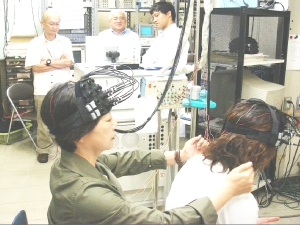
We thus hypothesized that Tapping Touch may enhance 5-HT neural activity. Tapping Touch involves a rhythmic behavior, i.e., rhythmically tapping with the hands of right and left alternately. Also, in clinical settings, it has been consistently evidenced that Tapping Touch has suppressive effects on anxiety, tension, pain and depressive symptoms.
Nine healthy volunteers, 18 to 76 years old, participated in this study. The research was conducted at the medical department of Toho University, in collaboration with Dr. Hideho Arita.
The subjects were paired and asked to do Tapping Touch with each other for 30 minutes (15 min. each). They were assessed at pre- and post-course, as described below.
The subjects' brain activities, such as alpha waves and frontal robe blood flow change, were also assessed with EEG and Brain Topography.
To assess the serotonergic neural activity, we sampled blood and urine before and after Tapping Touch. For analysis of 5-HT activity, we determined 5-HT levels quantitatively in the whole blood (WB) and urine (Urine) using HPLC system.
To assess psychological changes, standardized and validated self-report measures were administered: (1) the Profile of Mood State (POMS) and Visual Analogy Scale (VAS).
Results showed significant main effects of Tapping Touch on the 5-HT level. Furthermore, among the psychological parameters, 4 dimensions of the POMS (Tension-Anxiety, Depression-Dejection, Fatigue, Confusion) and all dimensions of VAS (Pain, Anxiety, Depression, Tension, Guilt, Stress) improved significantly after experiencing Tapping Touch.
Details of the research results are withheld for other scientific paper. Partial results are shown in the following graph.
Results were presented at the 68nd Convention of the Japan Society of Public Health (2009).
- Top of this page
- 1.Changes in Psychosomatic Senses
- 2.Changes in Anxiety Level
- 3.Changes in Brain Waves and Autonomic-Nervous System
- Summary of Neuro-Physiological Changes
- 4.Changes in Serotonin and Psychological States
Copyright 2010, The Association of Tapping Touch.
